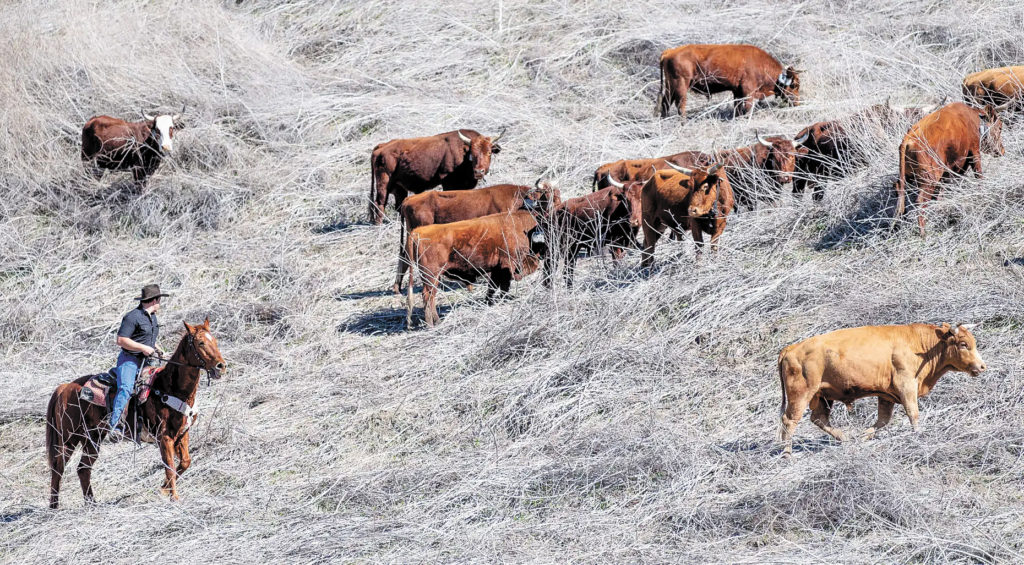
Rancher Ryan Fitzpatrick lets cattle from the 5 Bar Beef ranch graze on land owned by the Transportation Corridor Agency at the Live Oak Plaza Conservation Area in Trabuco Canyon, CA on Monday, February 22, 2021. The area, a 23-acre parcel at the corner of El Toro Road and Live Oak Canyon Road, is part of a three-year pilot program of fire mitigation and native species replenishment. (Photo by Paul Bersebach, Orange County Register/SCNG)
Frank Fitzpatrick is excited for a pilot project with the Transportation Corridor Agencies to show the good his cattle can do.
“Everyone hates cows because they’ve been fed a bill of goods that they are harmful,” he said about past damage done from cattle over-grazing on many of Orange County’s rolling hills. “Environmental degradation comes from man-made decisions. It’s not the cow; it’s the how.”
He hopes his small herd of 800-pound Barzona bulls the TCA has hired to graze on 23 acres off Live Oak Canyon Road that the transportation agency is tasked with preserving as open space will show how the cattle can be used in a beneficial, not destructive way.
By moving his cattle around and limiting their consumption – a practice Fitzpatrick has followed for decades – the animals can actually help to regenerate the soil and plants, he said. They eat plants that shouldn’t be there and the land also benefits from the nutrients that come from the cattle urinating and defecating.
By strategically moving the animals, it gives the land time to restore itself, he said.
The restoration that can be achieved not only helps the native plants grow, but also can reduce fire and flood risks.
The pilot project involves just a few of the 600-head herd that belongs to Fitzpatrick and his Orange County-based 5-Bar Beef Ranch and just a small portion of the TCA’s 2,000 acres of preserved open space that are spread across 17 sites in Orange County.
For the last six days, the bulls – which are wearing GPS-monitored collars that act as an invisible fence – have been pulling up and munching on non-native plant species that are just beginning to sprout. And while they dine, they are trampling the dry stalks of mustard seed plants that have formed a thick layer over the ground, helping expose the sprouting native grasses below to sunlight and moisture so they can grow and take over areas invaded by non-native plants.
The effort is all about timing. The non-native plants often sprout first, said Doug Feremenga, the TCA’s environmental planning manager. That pushes out the plants that are meant to grow and support the local ecosystem.
After 13 days, the bulls are moved to another area before they can eat the native plants, and the process begins again. The practice is called conservation grazing.
The collars – which are part of another project Fitzpatrick is involved in – keep the cattle in the area they need to be. If they roam near the borders, they’re warned with a loud beeping sound. If they step beyond the virtual boundary, they receive a zap just like from an electric fence.
For the TCA, the goal is to mitigate wildfire risk and help bring back some of the riparian grasses and coastal sage scrub that support the threatened coastal California gnatcatcher and the endangered Riverside fairy shrimp.
Feremenga said the effort is “mutually beneficial.”
TCA biologists will monitor the sites and collect data to use in planning restoration of some of their other conservation lands in the county.
“This is a cutting edge program in Orange County,” Fitzpatrick said.
His effort, he said, is focused on changing public opinion about land use and the importance of holistic, planned grazing as a form of regenerative agriculture. The project is part of the Holistic Education for Reversing Desertification, or HERD, Foundation he started two years ago.
Once COVID-19 gets out of the way, Fitzpatrick said he plans to include public presentations about the conservation efforts on the land. Fitzpatrick also has plans to work with Future Farmers of America and 4-H groups in the county.
Because the TCA parcel across from Cook’s Corner in Trabuco Canyon where the project is being tried has been fallow for a while now, there won’t be enough plants for the cattle to consume, so Fitzpatrick said he has to supplement their food with extra protein. He will also supply water and salt blocks.
The pilot is expected to last three years and Fitzpatrick is being paid $11,500 annually to graze his cattle three times each year.
By Erika I. Ritchie, The Orange County Register
